
Ajmerpronounced [ədʒmeːr](listen) is one of the major and oldest cities in the Indian state of Rajasthan and the centre of the eponymous Ajmer District. It is located at the centre of Rajasthan. The city was established as "Ajayameru" by a Chahamana ruler, either Ajayaraja I or Ajayaraja II, and served as their capital until the 12th century CE. Home to the dargah of Moinuddin Chishti, Ajmer is one of the most important destinations of Islamic pilgrimage in South Asia.
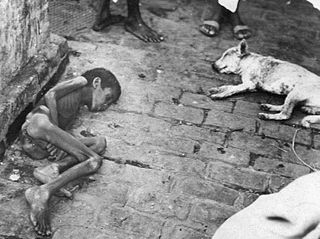
A famine is a widespread scarcity of food, caused by several factors including war, natural disasters, crop failure, population imbalance, widespread poverty, an economic catastrophe or government policies. This phenomenon is usually accompanied or followed by regional malnutrition, starvation, epidemic, and increased mortality. Every inhabited continent in the world has experienced a period of famine throughout history. In the 19th and 20th century, generally characterized Southeast and South Asia, as well as Eastern and Central Europe, in terms of having suffered most number of deaths from famine. The numbers dying from famine began to fall sharply from the 2000s. Since 2010, Africa has been the most affected continent in the world.

The 1931 China floods, or the 1931 Yangtze–Huai River floods, occurred from June to August 1931 in China, hitting major cities such as Wuhan, Nanjing and beyond, which eventually culminated into a dike breach along Lake Gaoyou on 25 August 1931.
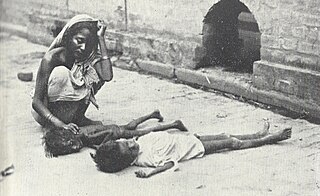
The Bengal famine of 1943 was a famine in the Bengal province of British India during World War II. An estimated 2.1–3 million, out of a population of 60.3 million, died of starvation, malaria, and other diseases aggravated by malnutrition, population displacement, unsanitary conditions and lack of health care. Millions were impoverished as the crisis overwhelmed large segments of the economy and catastrophically disrupted the social fabric. Eventually, families disintegrated; men sold their small farms and left home to look for work or to join the British Indian Army, and women and children became homeless migrants, often travelling to Calcutta or other large cities in search of organised relief. Historians usually characterise the famine as anthropogenic (man-made), asserting that wartime colonial policies created and then exacerbated the crisis. A minority view holds, however, that the famine was the result of natural causes.
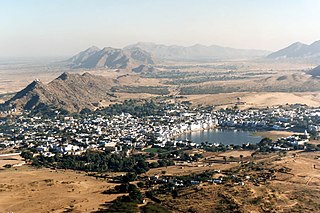
Pushkar is a city in the Ajmer district in the Indian state of Rajasthan. It is situated about 10 km (6.2 mi) northwest of Ajmer and about 150 kilometres (93 mi) southwest of Jaipur. It is a pilgrimage site for Hindus and Sikhs. Pushkar has many temples. Most of the temples and ghats in Pushkar are from the 18th century and later, because many temples were destroyed during Muslim conquests in the area. Subsequently, the destroyed temples were rebuilt. The most famous among Pushkar temples is the red spired Brahma Temple built by Gurjar Samrat Pushkar, who is father of Vedmata Gayatri, who was a chechi kanya married to Lord Brahma. It is considered a sacred city by the Hindus particularly in Shaktism, and meat and eggs consumption are forbidden in the city. Pushkar is located on the shore of Pushkar Lake, which has many ghats where pilgrims bathe. Pushkar is also significant for its Gurdwaras for Guru Nanak and Guru Gobind Singh. One of the bathing ghats is called Gobind ghat built by the Sikhs in the memory of Guru Gobind Singh.

Marwar is a region of southwestern Rajasthan state in North Western India. It lies partly in the Thar Desert. The word 'maru' is Sanskrit for desert. In Rajasthani dialect, "wad" means a particular area. English translation of the word 'marwar' is 'the region of desert.'

Bhilwara is a city in the Mewar region of Rajasthan, India. It has been termed as 'Textile city'.
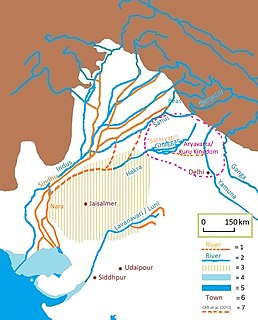
The Luni is the largest river in the Thar Desert of northwest India. It originates in the Pushkar valley of the Aravalli Range, near Ajmer, passes through the southeastern portion of the Thar Desert, and ends in the marshy lands of Rann of Kutch in Gujarat, after travelling a distance of 495 km (308 mi). It is first known as Sagarmati, then after passing Govindgarh, it meets its tributary Sarasvati, which originates from Pushkar Lake and from then on it is called Luni.

Pushkar Lake or Pushkar Sarovar is located in the town of Pushkar in Ajmer district of the Rajasthan state of western India. Pushkar Lake is a sacred lake of the Hindus. The Hindu scriptures describe it as "Tirtha-Guru" – the perceptor of pilgrimage sites related to a water-body and relate it to the mythology of the creator-god Brahma, whose most prominent temple stands in Pushkar. The Pushkar Lake finds mention on coins as early as the 4th century BC.
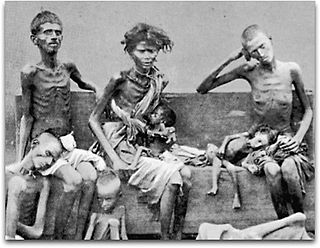
Famine had been a recurrent feature of life in the Indian sub-continental countries of India, Pakistan and Bangladesh, most accurately recorded during British rule. Famines in India resulted in more than 30 million deaths over the course of the 18th, 19th, and early 20th centuries. Famines in British India were severe enough to have a substantial impact on the long-term population growth of the country in the 19th and early 20th centuries.

Kishangarh is a city and a Municipal Council in Ajmer district in the Indian state of Rajasthan. It was built by the Rajgharanas and Maharajas of Jaipur and Jodhpur. It lies 18 miles northeast of Ajmer and 90 km far away from Jaipur. It is connected via Kishangarh Airport, Indian Railways' Kishangarh Railway Station and National Highway #8 #79. It is the birthplace of the Kishangarh style of painting, which is known for the depiction of a courtesan known as Bani Thani. Kishangarh has come to be known as the Marble city of India. It has heritage lake named as Gundolav Lake. Kishangarh Nepheline Syenite, located about 500 m after the bypass bifurcation of Kishangarh towards Jaipur on NH-8, has been notified as one of the National Geographical Monument of India.

Phulera is a town and a part of the Jaipur district in the Indian state of Rajasthan. The DMIC project runs through Phulera. It is a major railway junction.
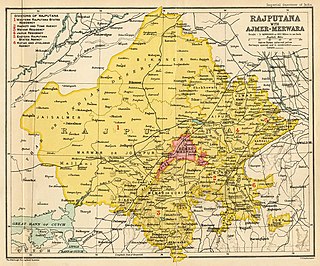
The Rajputana famine of 1869 affected an area of 296,000 square miles (770,000 km2) and a population of 44,500,000, primarily in the princely states of Rajputana, India, and the British territory of Ajmer. Other areas affected included Gujarat, the North Deccan districts, the Jubbalpore division of the Central Provinces and Berar, the Agra and Bundelkhand division of the United Provinces, and the Hissar division of the Punjab.

The Bihar famine of 1873–1874 was a famine in British India that followed a drought in the province of Bihar, the neighboring provinces of Bengal, the North-Western Provinces and Oudh. It affected an area of 140,000 square kilometres (54,000 sq mi) and a population of 21.5 million. The relief effort—organized by Sir Richard Temple, the newly appointed Lieutenant-Governor of Bengal—was one of the success stories of the famine relief in British India; there was little or no mortality during the famine.

The Great Famine of 1876–1878 was a famine in India under Crown rule. It began in 1876 after an intense drought resulting in crop failure in the Deccan Plateau. It affected south and Southwestern India—the British-administered presidencies of Madras and Bombay, and the princely states of Mysore and Hyderabad—for a period of two years. In 1877 famine came to affect regions northward, including parts of the Central Provinces and the North-Western Provinces, and a small area in the Punjab. The famine ultimately affected an area of 670,000 square kilometres (257,000 sq mi) and caused distress to a population totalling 58,500,000. The excess mortality in the famine has been estimated in a range whose low end is 5.6 million human fatalities, high end 9.6 million fatalities, and a careful modern demographic estimate 8.2 million fatalities. The famine is also known as the Southern India famine of 1876–1878 and the Madras famine of 1877.

The Indian famine of 1899–1900 began with the failure of the summer monsoons in 1899 over Western and Central India and, during the next year, affected an area of 476,000 square miles (1,230,000 km2) and a population of 59.5 million. The famine was acute in the Central Provinces and Berar, the Bombay Presidency, the minor province of Ajmer-Merwara, and the Hissar District of the Punjab; it also caused great distress in the princely states of the Rajputana Agency, the Central India Agency, Hyderabad and the Kathiawar Agency. In addition, small areas of the Bengal Presidency, the Madras Presidency and the North-Western Provinces were acutely afflicted by the famine.

Ana Sagar Lake is an artificial lake situated in the city of Ajmer in Rajasthan state in India. It was built by Arnoraja, the grandfather of Prithviraj Chauhan, in 1135 -1150 AD and is named after him. The catchments were built with the help of local populace. The lake is spread over 13 km (8.1 mi). The Baradari or pavilions were built by Shahjahan in 1637 and Daulat Bagh Gardens by Jehangir.

Kishangarh Airport, Ajmer is a regional airport situated at Kishangarh on National Highway 8, 27 km North-East of Ajmer in Rajasthan, India. The airport was inaugurated on 11 October 2017. It is operated by the Airports Authority of India (AAI), covers an area of 742 acres and has a 2,000 metre long runway. It is also famous for Bani Thani painting. The airport is expected to facilitate transport to the pilgrim sites like the Dargah of Khwaja Garib Nawaz, Pushkar and fort of Prithvi Raj Chauhan in the city of Ajmer.

Udaipur City railway station is a railway station located in Udaipur, Rajasthan, India. The railway station is under the administrative control of North Western Railway of Indian Railways.

The Islamic Cultural Centre of Quebec City is an organization dedicated to meeting the spiritual, social and economic needs of the Muslim community residing in Quebec City, Quebec, Canada. Its main place of worship is the Great Mosque of Quebec City.



















